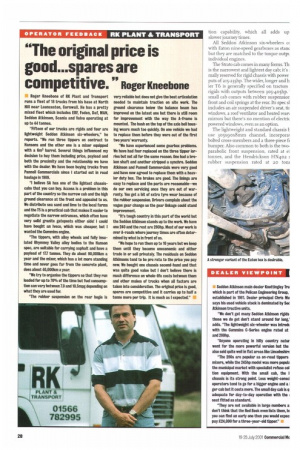TOOLS
Page 25

Page 28

Page 29

If you've noticed an error in this article please click here to report it so we can fix it.
OF THE
TRADE
Any shortlist of six-wheel tankers, tippers or mixers will include the lightweight Seddon Atkinson Strato with Cummins C-Series engine and narrow T5 daycab.
Operators give the low-down.
ince the demise of the Ford Cargo plant at Langley, The Seddon Atkinson factory at Oldham is Iveco's only manufacturing base in the UK. After years of passing from hand to hand it now seems settled within the Iveco Group as a specialist truck builder. But unlike any other Iveco plant in Europe, Oldham mixes Iveco components with a range of proprietary components.
Seddon Atkinson has a long history of building six-wheelers. After the Second World War Atkinson Vehicles based its reputation as a heavy truck builder on a series of 6x4s. In the 196os the Atkinson name became prominent for supplying some 400 all-wheel-drive gritters to the old Ministry of Transport—for many years these bright yellow wagons kept Britain's motorways clear of snow and ice.
In those days six-wheelers where still popular as general haulage vehicles; today their main role lies within the construction industry as base chassis for mixer or tipper equip
ment and Seddon Atkinson has also carved !:t' out a niche in the refuse collectionz
market' E
A six-wheeler needs to be light but strong. u
The payload is bound to be less for a 26-tonner than an eight-wheeler running at 32 r-g tonnes, but the smaller multi-wheeler, with its shorter wheelbase and tighter turning circle, can get into difficult sites much more easily g than an eight-legger.
To maximise payload potential Seddon Atkinson offers two lightweight models alongside three standard 6x4 chassis: the main differences include the engine, transmission • and cab specifications. The lightweight models use the 8.3-litre Cummins C-Series straight-six rated at 245 and 280hp; the heavier models get Cummins' ro.8-litre Mir at 305, 340 and 380hp.
The smaller engines rev higher and have substantially less to offer in the way of torque, so if your top priority is off-road mud plugging the lightweight is probably not the option for you. A combination of lower power and torque also reduces hillclimbing and acceleraD
tion capability, which all adds up slower journey times.
All Seddon Atkinson six-wheelers c( with Eaton nine-speed gearboxes as stam but they are matched to the torque outpt individual engines.
The Strato cab comes in many forms. Th is the narrowest and lightest day cab: it's mally reserved for rigid chassis with power puts of 215-235hp. The wider, longer and h jet T6 is generally specified on tractors rigids with outputs between 3o5-4o5hp. small cab comes with rubber suspensior front and coil springs at the rear. Its spec sl includes an air suspended driver's seat, tit windows, a roof ventilator and heated rean mirrors but there's no mention of electric powered windows, even as an option.
The lightweight and standard chassis b use 3o5x9ox8mrn channel, incorporai bolted cross-members and a three-piece fi bumper. Also common to both is the twoparabolic front suspension, rated at ei tonnes, and the Hendrickson HN402 rubber suspension rated at 20 tom However the brakes are slightly narrower on the lightweight model.
Four wheelbases range from 4.52-5.85m: the shortest lightweight chassis weighs in at 6.99 tonnes with 2 full zoo-litre tank—a saving of 5t3kg on the more powerful models.
• by Bill Brock














































































































